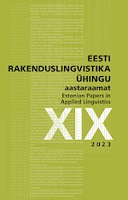Keelelised valikud kriisi kommunikatsioonis: koroonasilt keeleteadlase töölaual
Linguists meet the pandemic: Crisis communication on COVID-19 signs in Estonia
Author(s): Ilona TragelSubject(s): Sociolinguistics, Baltic Languages, Health and medicine and law
Published by: Eesti Rakenduslingvistika Ühing (ERÜ)
Keywords: COVID-19 public signs; linguistic landscape; interpersonality; intertextuality; crisis communication; Estonian;
Summary/Abstract: In this article, public messages concerning the pandemic are studied as an example of crisis communication. An overview of the usage of public COVID-19 signs in Estonia during the pandemic is given. The COVID-19 sign is described as a communication act between the participants: the sign’s author (institution) and the addressee (client), who share the discourse of the pandemic including local measures implemented by the Estonian government. The traditional framework for researching public signs has been the Linguistic Landscape. The number of signs that has now emerged, however, allows us to study linguistic means on the signs from many new perspectives. Moreover, the global pandemic discourse provided a unifying feature for public COVID-19 signs all over the world, enabling us to compare the signs across countries. The results of a quantitative analysis of 900 Estonian COVID-19 door signs are presented. Relations between the participants of the communication act are studied from the perspectives of interpersonality (e.g., grammatical person) and intertextuality (means of expressing government regulations in the sign’s text). Furthermore, an overview of the previous studies of COVID-19 signs is given: authority and solidarity in the use of grammatical person, the comparison of signs in China and Estonia, expressing the cause, an experiment of perception of the use of person, speech acts of greetings and wishes. Moreover, various data about COVID-19 signs is presented, such as the most common words per word class: e.g., the most common adjective was hea ‘good’, the most common noun was mask ‘mask’ and the most common verb was sulgema ‘to close’. Quantitative data on the signs’ length is also provided. As might be expected, the overall length of the signs becomes shorter as the pandemic progresses since the authors have no need to explain the already familiar situation on the signs (the median length of a sign was 16 words during the first wave and 10 words during the third wave). Intertextual relations are also discussed in the article, e.g., how government regulations are referred to on the sign. Another interesting manifestation of intertextuality is reference to other genres: a sign could be written in verse or paraphrase a well-known nursery rhyme. Authors’ ideological stance can also be reflected on the sign, e.g., instead of referring to the measures as the cause of closing, one sign announces that the prime minister and minister of social affairs are “bullying”. It can thus be said that public COVID-19 signs are interesting and diverse research material. As messages created spontaneously in a time of crisis, they allow us to analyze how the use of language reflects the authors’ stance, and how grammar and intertextuality influence the perception and effect of the signs.
Journal: Eesti Rakenduslingvistika Ühingu aastaraamat
- Issue Year: 2023
- Issue No: 19
- Page Range: 195-223
- Page Count: 29
- Language: Estonian

